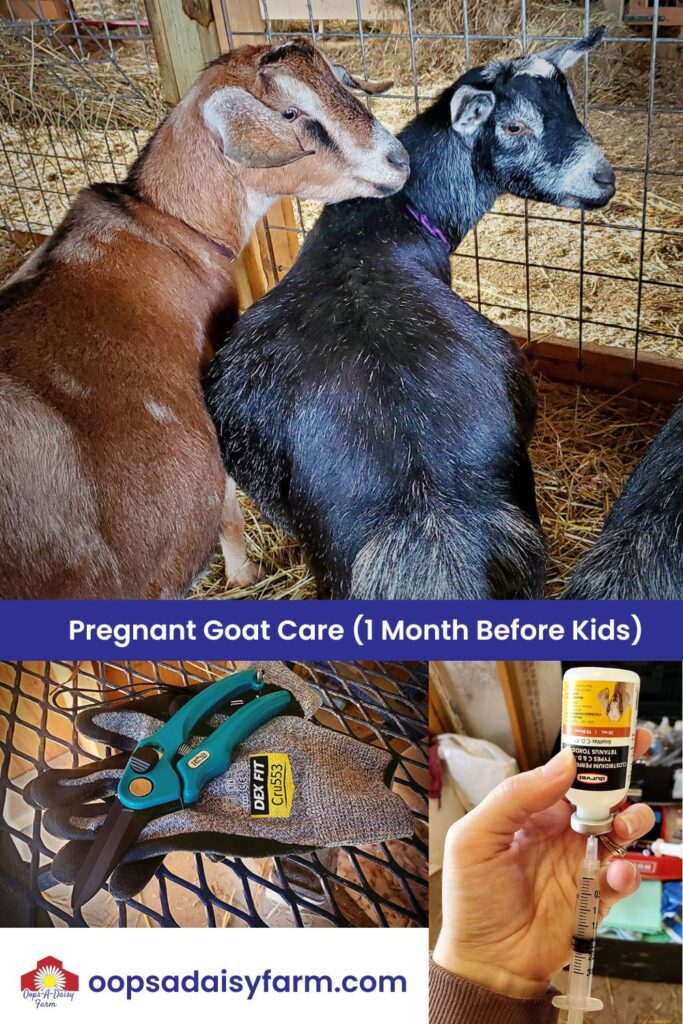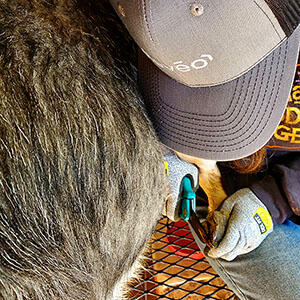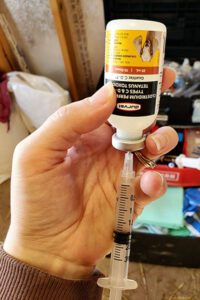This site contains affiliate links. If you make a purchase using one of these links, I may earn a small commission at no additional cost to you. Click here to read our full disclosure, including information about cookies collected and our privacy policy.
Trimming hooves, updating vaccinations, and providing mineral supplements are important to keep our does healthy during the last month of their pregnancy. This care is also important for the kids they are carrying, and gives the babies their best chance to arrive strong and healthy!

Kidding season is almost here! Several of our does are already carrying “wide loads,” and the human kids and I are taking bets on how many newborn goats will be arriving this year. With roughly a month before our does start to freshen, it’s time to give them a little extra TLC. Consider it pre-natal care for goats!
How to Care for Pregnant Goats (1 month before kidding)
Hoof Care
Ideally, we’d put our goats on a rotational calendar and trim their feet 6-8 times a year. Realistically though? They get their feet trimmed 3-4 times per year, or as I notice someone whose toes are looking a little too long. (Goals for a new year, right?)

During the summer, all the goats spend more time outdoors. With the climbing rocks we have piled around the barn, their hooves are naturally ground down and they don’t need as much help. In the winter, hanging out in the barn stalls, their hooves tend to get more overgrown. That makes this time before kidding a good time to clean up overgrown winter feet!
I’ve found if we trim hooves about a month before a doe freshens her pedicure will last until after the kids are born. She’ll be standing properly on her feet for that last month when she is heavy and uncomfortable.
For hoof trimming, we use these hoof trimmers from Tractor Supply. They last a couple of years before they get too dull to cut cleanly. Last year, we also started wearing cut-resistant gloves when trimming feet. They help prevent nasty deep cuts to your hand if a doe suddenly pulls her foot away or kicks!
Vaccinations

Our does receive their annual Clostridium Perfringens & Tetanus (C.D.-T) boosters about 4 weeks before kidding. This annual vaccination is almost universally recommended for goats and helps prevent enterotoxemia and tetanus in the doe and her kids. The kids will have residual protection through the doe’s colostrum that lasts until they receive their first dose of CD&T at 5-8 weeks old.
Enterotoxemia is caused by the clostridium perfringens bacteria, primarily strains C & D in the U.S. It causes abdominal pain, discomfort, and often sudden death in goats. Treating enterotoxemia is usually not effective, so prevention is the best option.
When giving your goats a vaccine, it is important to follow directions on the label regarding dosage, storage and injection. Some vaccines are injected into the muscle, while others are injected under the skin. Talking to your local veterinarian will help you to decide if your goats needs additional preventative vaccines.
Vitamin & Mineral Supplements
Depending on where you live, your does may also need a vitamin or mineral supplement at this time. Before moving, we skipped this step, as our soil and feed contained adequate levels of selenium and calcium. Now, our does each receive a dose of Selenium & Vitamin E gel. This supplement will help prevent retained placenta, and kids that are too weak to stand and nurse.
By making time for some preventative care prior to kidding, you can help keep your does healthy. That way they can deliver healthy kids when the time comes!
Stay Up to Date
Sign up to receive our emails!
Thank you!
You have successfully joined our subscriber list.
You May Also Like:
- How to Choose the Right Livestock For Your Family
 Deciding when, how, and which livestock to add to your farm or homestead is a personal preference. Regardless of how big or small they are, all livestock come with chores,… Read more: How to Choose the Right Livestock For Your Family
Deciding when, how, and which livestock to add to your farm or homestead is a personal preference. Regardless of how big or small they are, all livestock come with chores,… Read more: How to Choose the Right Livestock For Your Family - Pregnant Goat Care (Countdown to Kidding)
 Trimming hooves, updating vaccinations, and providing mineral supplements are important to keep our does healthy during the last month of their pregnancy. This care is also important for the kids… Read more: Pregnant Goat Care (Countdown to Kidding)
Trimming hooves, updating vaccinations, and providing mineral supplements are important to keep our does healthy during the last month of their pregnancy. This care is also important for the kids… Read more: Pregnant Goat Care (Countdown to Kidding) - DIY Goat Kidding Pens
 Goat kidding pens are small pens, sized for a single doe and her newborn kids. This small pen provides a private space for a doe to give birth and bond… Read more: DIY Goat Kidding Pens
Goat kidding pens are small pens, sized for a single doe and her newborn kids. This small pen provides a private space for a doe to give birth and bond… Read more: DIY Goat Kidding Pens
